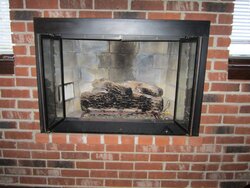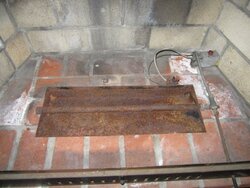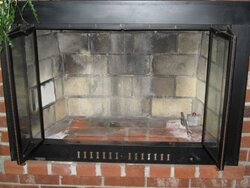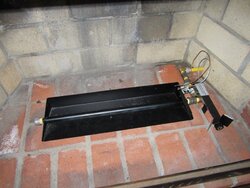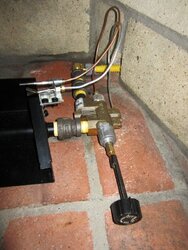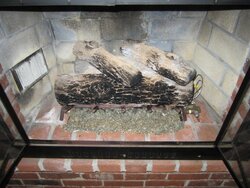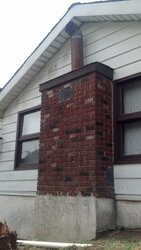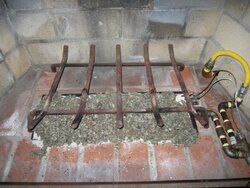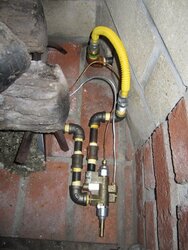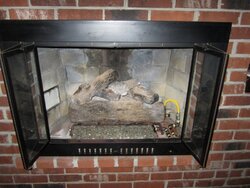My parents have a gas log fireplace in a back room that hasn't worked in 10 years. They asked me if I could get it working for them so I did some research,ordered some parts, got it working and now am doing a little more research. I feel i connected it correct but that the fireplace was just not built correctly. I'm including some pics since pics say 1000 words
From what I've read and understand this is a masonry fireplace. It has a gas insert with a gas log set. It is a b-vent system which means it takes combustible air from inside the room and vents the hot dangerous gas up the chimney. The room this is in has its own thermostat and hot water heating system so the fireplace is not the heating source. I've read that b vent systems are inefficient but this is mostly for show. Please let me know from pic if this seems like I have it correct.
Some questions:
1) why does this also have a vent in the fire box to the outside? I thought b vent systems draw combustible air from the room. Is this some version of an outside combustible air kit? Its basically just a hole in the brick to the outside. Its about 3 inches by 5 inches with metal grating so animals and bugs can't get in. Should I close this up? Does it help? I sent RH Peterson and email about their safety pilot and include a pic of my system. A person replied that I should seal up that fresh air vent as it can effect the burner adversely. Is that true?
2)The glass doors are bifold doors. Do these need to be open while the fire is on. Can they be closed since there is a vent on the left side of the firebox going outside. There are also vents on the bottom of the metal door frame that can be opened or closed. I recently ran this with the doors closed and the vents in the metal door frame open. After an hour I couldnt' even get close enough to the on/off knob to turn the fire off it was so hot in there. It has the metal heat shield on it. I had to go to the shutoff valve outside to shut off the fire. Did I install something wrong that the fireplace was so hot I couldn't shut it off?
3) the chimney outside does not go above the roof line. I believe this is illegal. The chimney ends about 5 feet short of the roof line and the b type metal liner goes up another 2 feet but is still below the roofline. The diameter of the metal liner is 7 inches. Is that an okay size.
As far as the parts I replace. I installed a new flexible hose from the gas line outside to the piping inside. I installed a new safety valve, a new burner pan. New sand for NG and added some embers. The grate and the ceramic logs set are the old ones as they looked in decent shape.
From what I've read and understand this is a masonry fireplace. It has a gas insert with a gas log set. It is a b-vent system which means it takes combustible air from inside the room and vents the hot dangerous gas up the chimney. The room this is in has its own thermostat and hot water heating system so the fireplace is not the heating source. I've read that b vent systems are inefficient but this is mostly for show. Please let me know from pic if this seems like I have it correct.
Some questions:
1) why does this also have a vent in the fire box to the outside? I thought b vent systems draw combustible air from the room. Is this some version of an outside combustible air kit? Its basically just a hole in the brick to the outside. Its about 3 inches by 5 inches with metal grating so animals and bugs can't get in. Should I close this up? Does it help? I sent RH Peterson and email about their safety pilot and include a pic of my system. A person replied that I should seal up that fresh air vent as it can effect the burner adversely. Is that true?
2)The glass doors are bifold doors. Do these need to be open while the fire is on. Can they be closed since there is a vent on the left side of the firebox going outside. There are also vents on the bottom of the metal door frame that can be opened or closed. I recently ran this with the doors closed and the vents in the metal door frame open. After an hour I couldnt' even get close enough to the on/off knob to turn the fire off it was so hot in there. It has the metal heat shield on it. I had to go to the shutoff valve outside to shut off the fire. Did I install something wrong that the fireplace was so hot I couldn't shut it off?
3) the chimney outside does not go above the roof line. I believe this is illegal. The chimney ends about 5 feet short of the roof line and the b type metal liner goes up another 2 feet but is still below the roofline. The diameter of the metal liner is 7 inches. Is that an okay size.
As far as the parts I replace. I installed a new flexible hose from the gas line outside to the piping inside. I installed a new safety valve, a new burner pan. New sand for NG and added some embers. The grate and the ceramic logs set are the old ones as they looked in decent shape.


